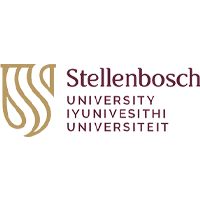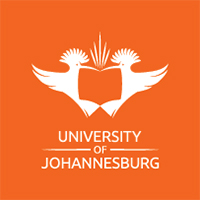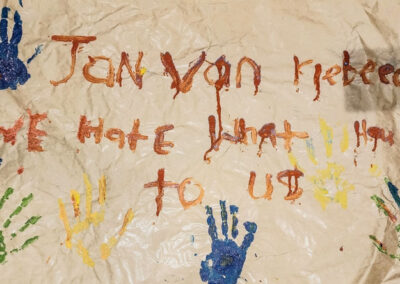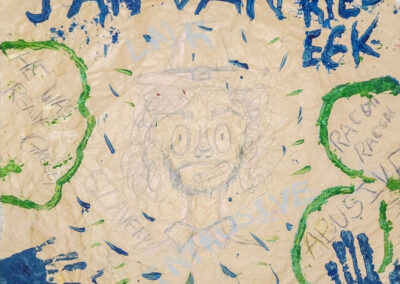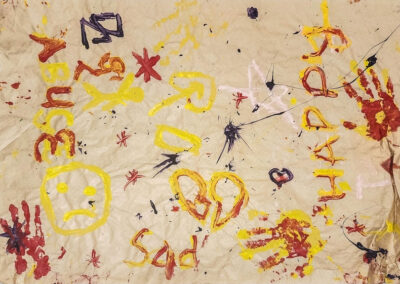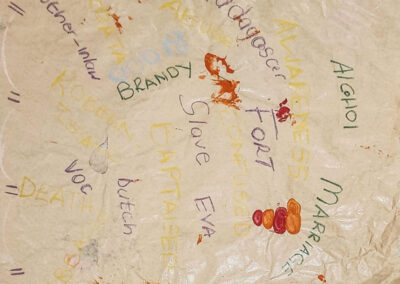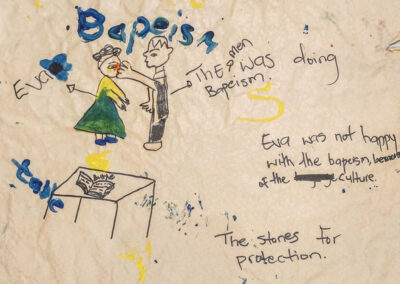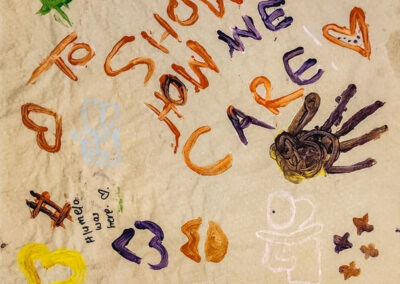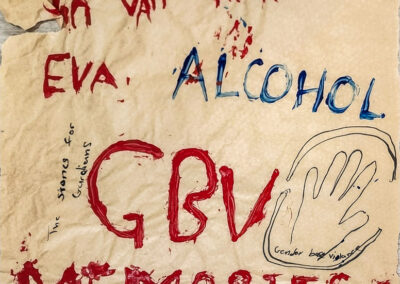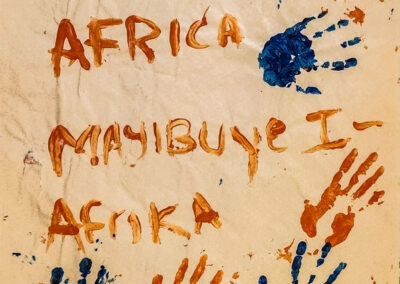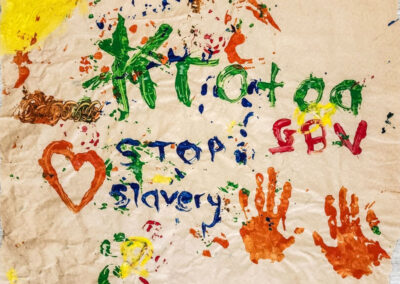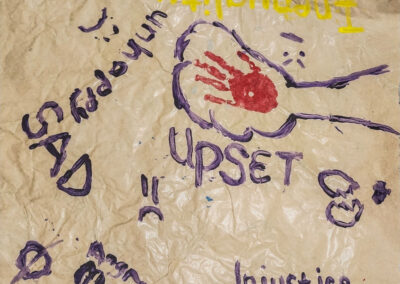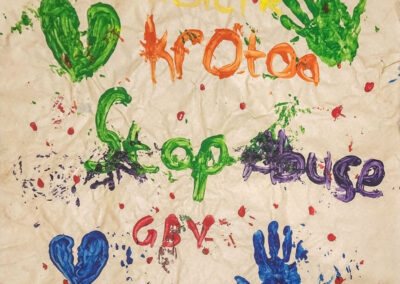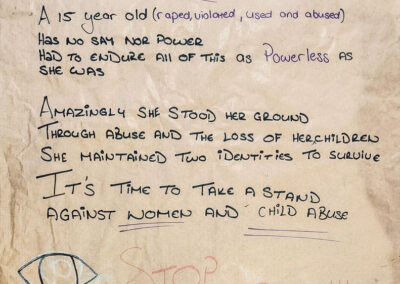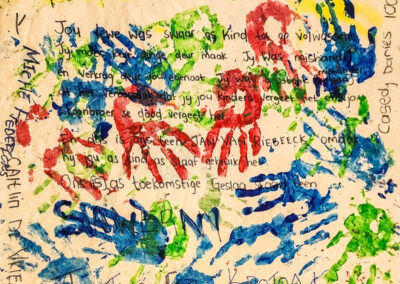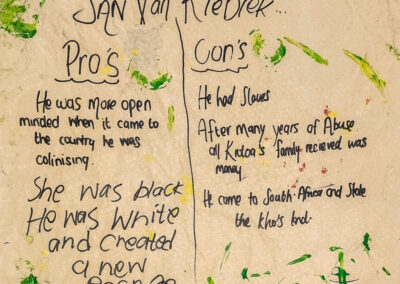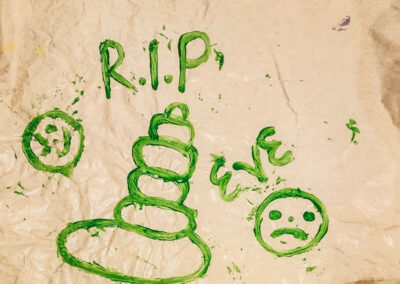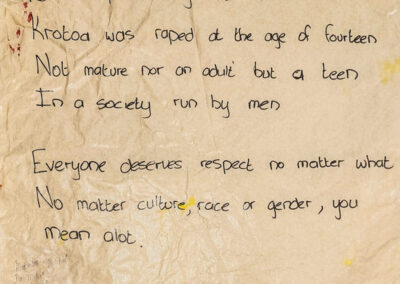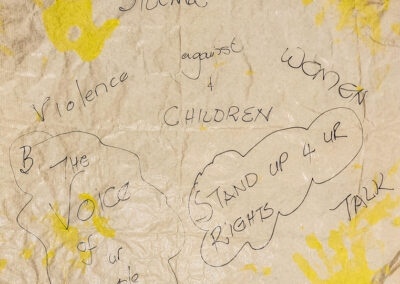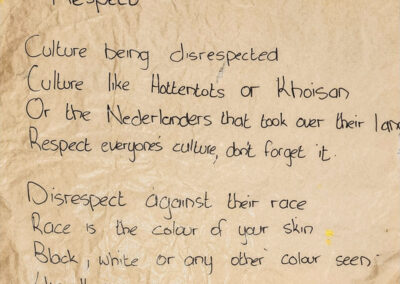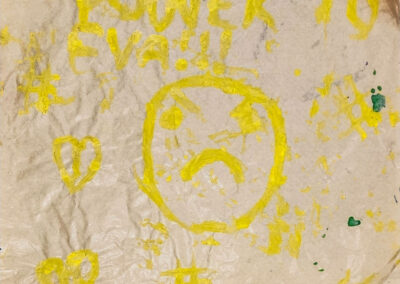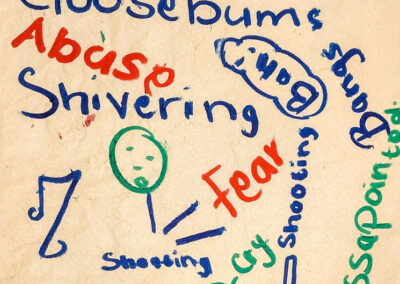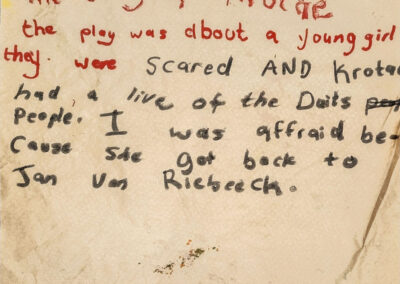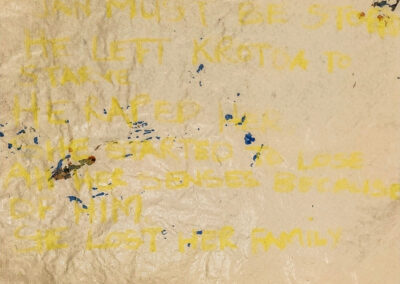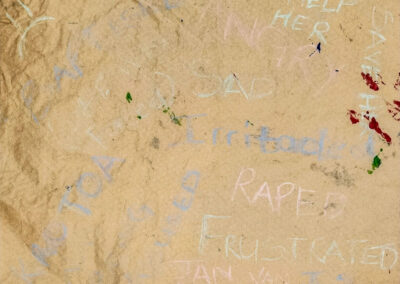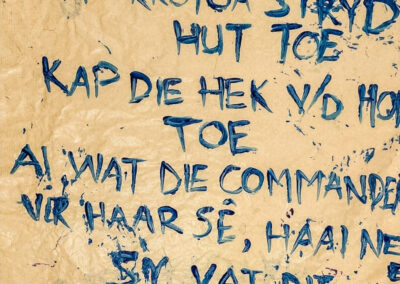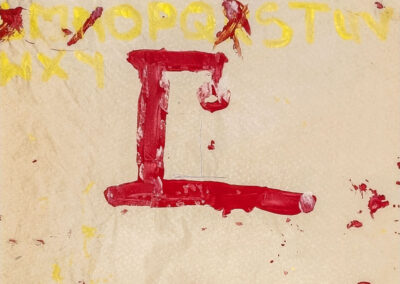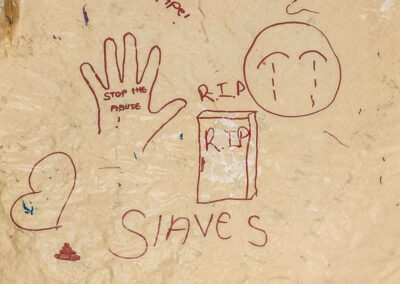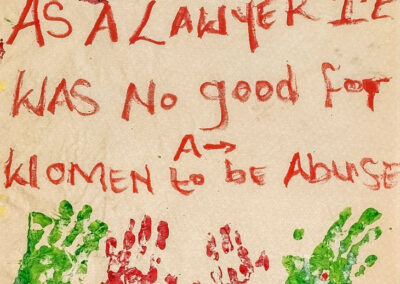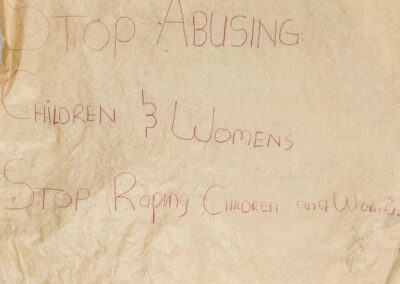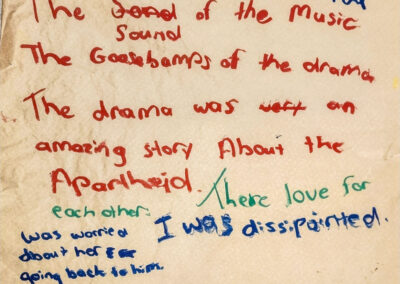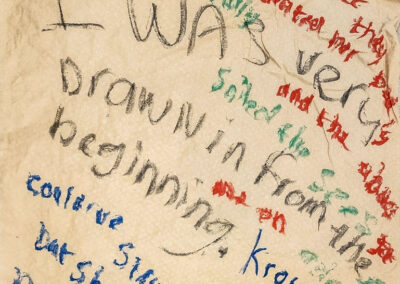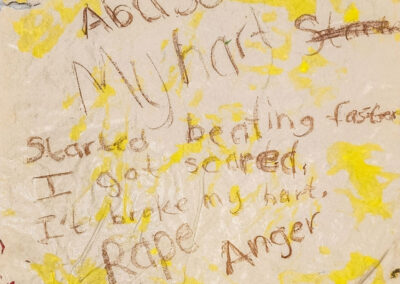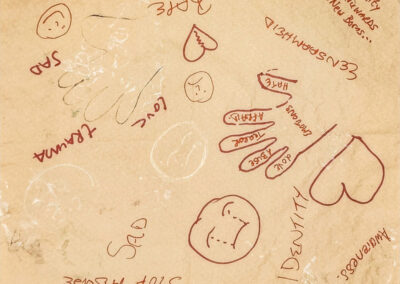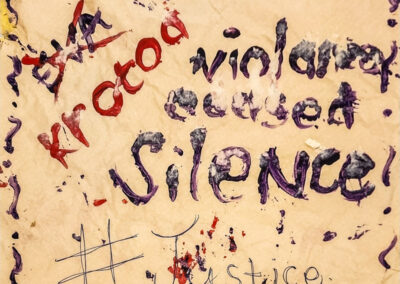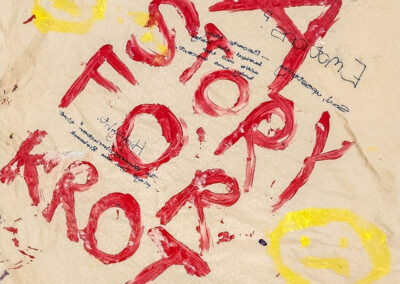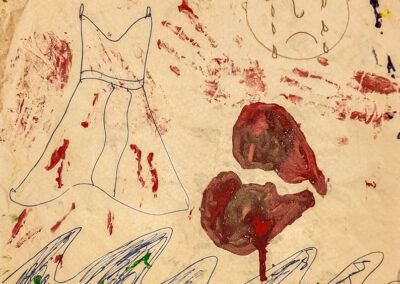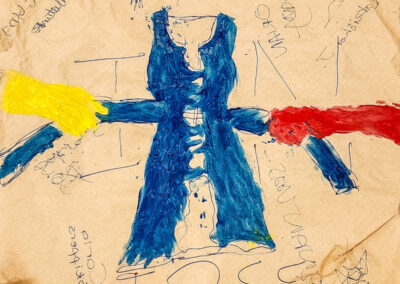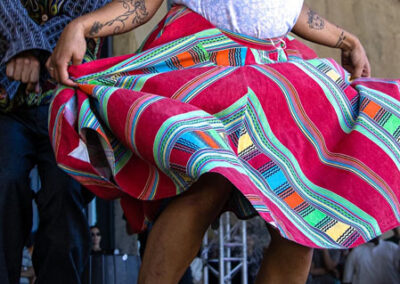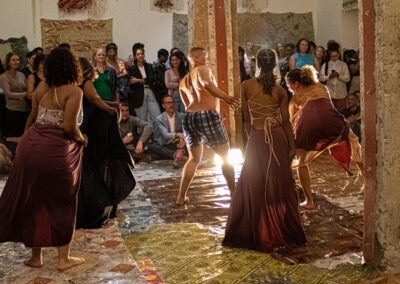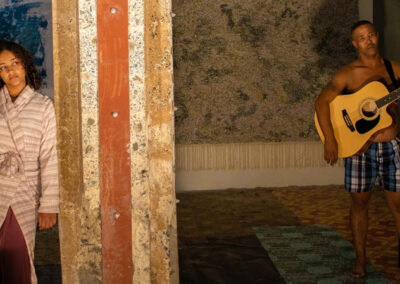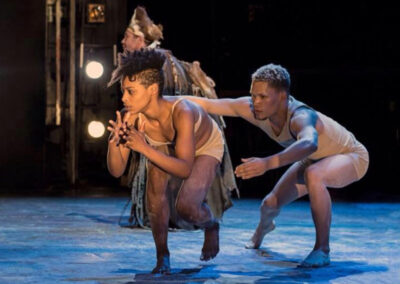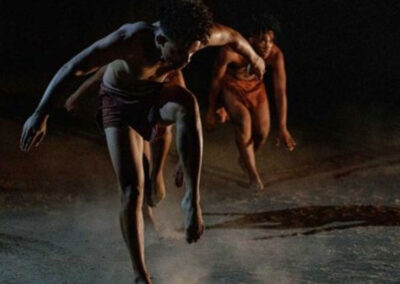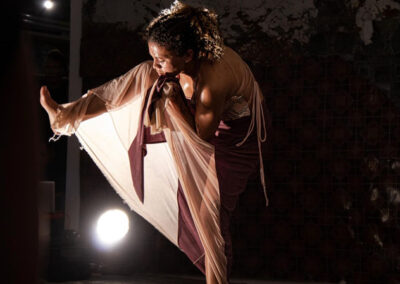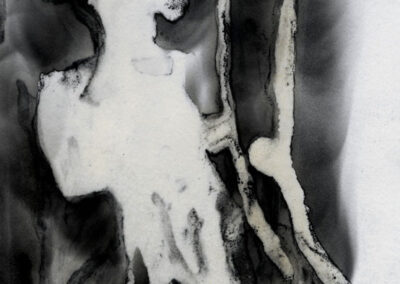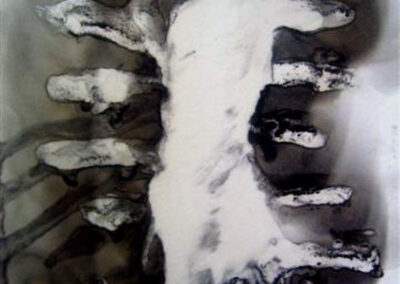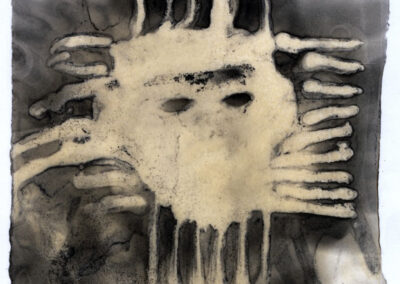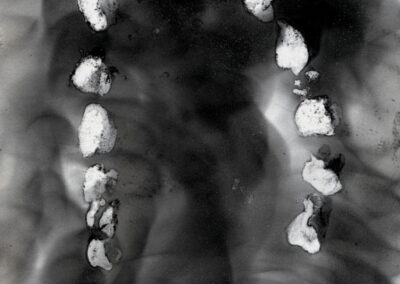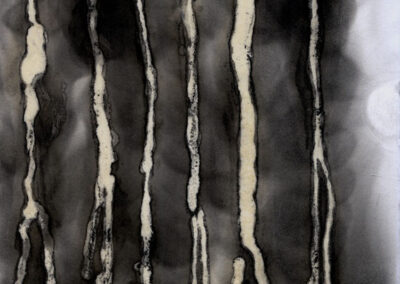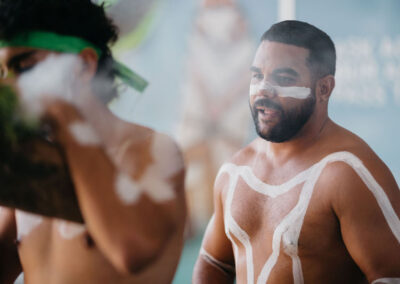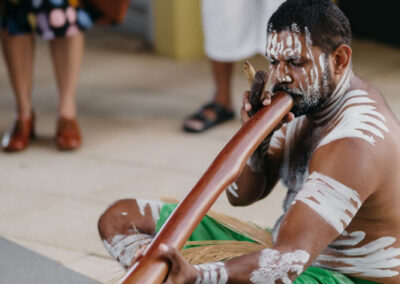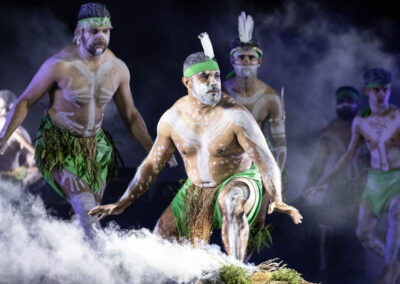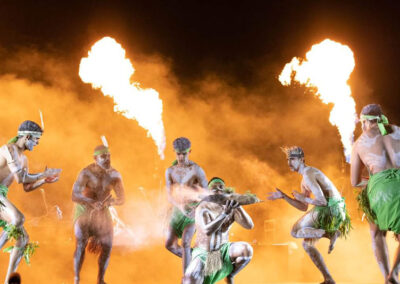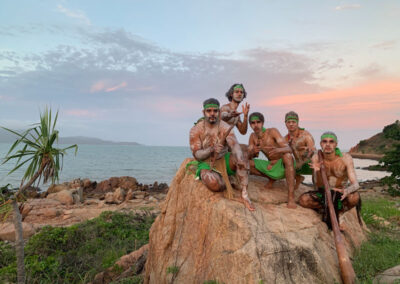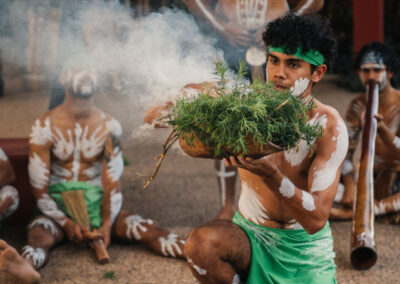A !Nau for Now:
Crossing Oceans Inside
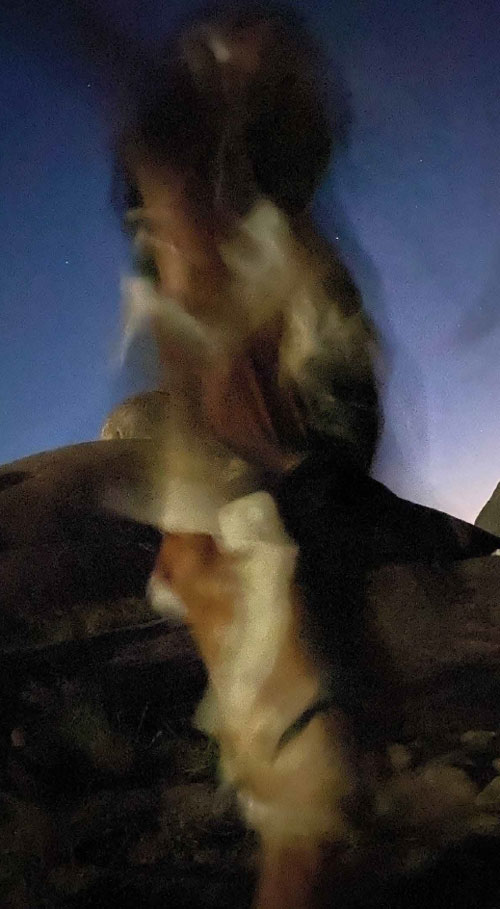
THE !NAU
Sida ge ra tsoatsoa
We are beginning
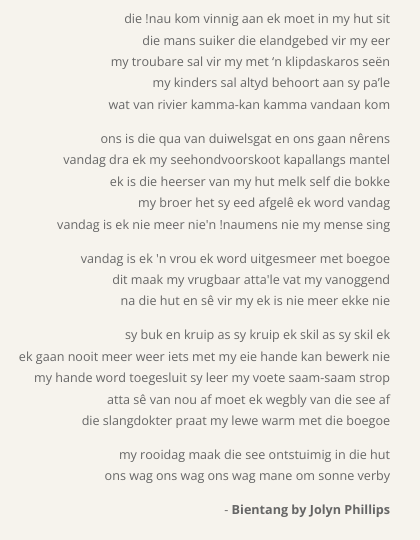
die !nau kom vinnig aan ek moet in my hut sit
die mans suiker die elandgebed vir my eer
my troubare sal vir my met ‘n klipdaskaros seën
my kinders sal altyd behoort aan sy pa’le
wat van rivier kamma-kan kamma vandaan kom
ons is die qua van duiwelsgat en ons gaan nêrens
vandag dra ek my seehondvoorskoot kapallangs mantel
ek is die heerser van my hut melk self die bokke
my broer het sy eed afgelê ek word vandag
vandag is ek nie meer nie’n !naumens nie my mense sing
vandag is ek ‘n vrou ek word uitgesmeer met boegoe
dit maak my vrugbaar atta’le vat my vanoggend
na die hut en sê vir my ek is nie meer ekke nie
sy buk en kruip as sy kruip ek skil as sy skil ek
ek gaan nooit meer weer iets met my eie hande kan bewerk nie
my hande word toegesluit sy leer my voete saam-saam strop
atta sê van nou af moet ek wegbly van die see af
die slangdokter praat my lewe warm met die boegoe
my rooidag maak die see ontstuimig in die hut
ons wag ons wag ons wag mane om sonne verby
– Bientang by Jolyn Phillips
Krotoa’s story has been held captive by the confines of colonialism and apartheid. In recent times she has become a symbol for people whose history has been destroyed and for those confined in a prison of the mind. To free her story and ourselves, we are called upon to delve into the world of Spirit where the Ancients walk among us. She has exploded onto our awareness because her story has not ended.
Ek sit nou op my gemak in the geselskap van Groot Mense
Ritual is the way we sharpen the tools we have been given to access the Divine within. The !Nau is one of the most important rites to cross the oceans inside and journey to a place of true knowing.
For South Africa’s First Nations the !Nau is an initiation or rite of passage ceremony. The !Nau also marks an important transition in the life of a person or a community. It has become a tool for raising cultural awareness and for spiritual revival.
This Exhibition captures a glimpse of the collective !Nau awareness that is happening to many of us, whether we are engaged in formal rituals or not. The Exhibition opens against the backdrop of the !Nau being performed for Krotoa, at a sacred site elsewhere, because she was denied this ancient rite when she worked as a servant for the colonials in the 1600s.
The renaming ceremony for the Krotoa Building on the Stellenbosch University (SU) campus is the context within which the !Nau for Now – Crossing Oceans Inside project is happening. It is part of the university’s Visual Redress programme, directed by the institution’s division for Social Impact and Transformation.
We have avoided the use of problematic or contested terms to describe people and groups. The generic terms First Nations or indigenous are placeholders for the myriad groupings that make up the descendants of the original custodians of this land.
The three phases of the !Nau are Separation, Transition and Re-membering or Reintegration. As part of the !Nau for Now Crossing Oceans Inside project, this ancient ceremony is being performed for Krotoa and women everywhere who have been robbed of their culture and traditions.
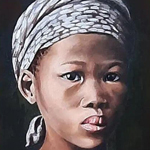
Krotoa !Go/Gõas
Krotoa !Goa /Gõas ‘Eva’ van Meerhof of the ǁAmmaqua and Goringhaiqua lives at a time … read more
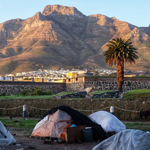
Separation
On day one of the !Nau is a water ceremony … read more
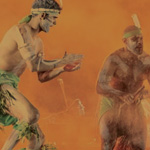
Transition
In the Transition from a traumatic past to a new understanding … read more
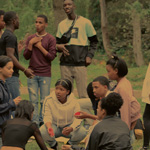
Re-membering
There is a visit from The Mantis everywhere I live … read more
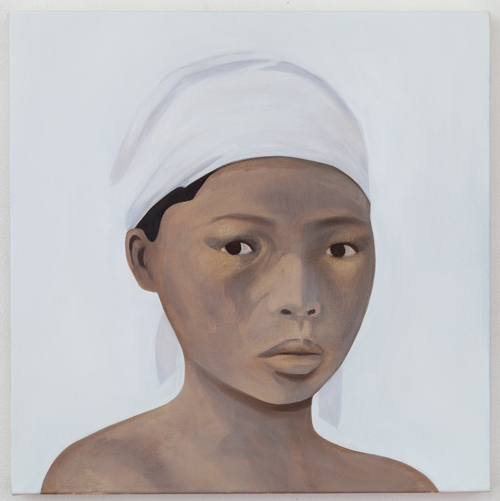
Portrait by Thenjiwe ‘Niki’ Nkosi. This image is not a likeness of Krotoa and research has shown it has been used mistakenly.
Context
Krotoa !Goa /Gõas ‘Eva’ van Meerhof of the ǁAmmaqua and Goringhaiqua lives at a time when the sparkling waters of the Camissa River flow freely from Hoerikwaggo to the Bay of ǁHui !Gaeb… from Table Mountain to the sea. She is born around 1642. Her name means a child in the wardship of others. Krotoa’s world is dominated by a busy port that has become a halfway station for merchant ships. Her Uncle Autshumao is a Goab or Leader of the ǁAmmaqua. They call themselves the ‘People of the Water’ or ‘Watermans’. The Dutch call Autshumao ‘Herry’. It is possibly a mispronunciation of Ari, one of his epithets, and is typical of the exchange of poetic nomenclature for invariably pedestrian colonial versions. Autshumao means ‘one who swims with the fish’. He runs a dynamic business supplying passing ships with food and drink.
The circumstances under which Krotoa leaves the wardship of her uncle at about 10 years old and enters the household of the Dutch East India Company or VOC colonial commander Jan Van Riebeeck as a child servant are contested. But it is clear from the copious references to her in the journals and letters of this commander (notorious for some and a folk hero for others) as well as his successor Zacharias Wagenaer that she is a key figure at the Cape in the 17th Century. We know from the archives that in addition to her own, she spoke several languages including Dutch, Afrikaans, Portuguese and even a bit of French. She learns these languages and the skill of negotiation at an early age by being a helper for her Uncle in his business as a trader.
By the time Krotoa is a teenager she has two children. Despite the meticulous record keeping of the VOC officers, Van Riebeeck and Wagenaer do not disclose how a youth in their care becomes pregnant. In a fort bursting with rough necks who are without women from their home countries, it is likely that Krotoa is abused from an early age. One of the clearest indications of the abusive treatment of Krotoa and others comes after 402 traumatised enslaved children arrive at the Cape in 1658 from Angola and Benin. Van Riebeeck orders that they be given daily rations of alcohol and tobacco to pacify them. He also records that plying people with these addictive substances, will make commercial trade negotiations much easier.
Krotoa’s Dutch is greatly improved living in the Fort with the Van Riebeecks and so, the weighty responsibility of translation is added to her duties. When the first war breaks out between the indigenous people and the colonials in 1659 Krotoa is the chief translator cum negotiator. In the letters and journals of Van Riebeeck as well as those of Wagenaer, there is both praise for her work and mistrust of her affiliations. Krotoa walks a tightrope between the growing colonial demands and the suspicions of her own people. She spends ten years of her life with the Van Riebeecks, six of these years as a VOC interpreter, emissary and diplomat. But her loyalty to her uncle and her people is self-evident in the archives. Van Riebeeck accuses her of “drawing the long bow” – contemporary colloquialism for misleading the Dutch – and also says that at times she is; “… telling us what she thinks we want to hear.”
In her early 20s Krotoa decides on a strategy, no doubt for her own protection, of being baptised in the foreign church and marrying the surgeon Pieter van Meerhof (aka the Dane Peter Havgardt). The Dutch change her name to Eva. She becomes the first local person to marry a colonial and to adopt their faith. This resourceful young woman is additionally protected by the fact that her sister is married to the powerful leader of the Cochoqua, Chief Oedasoa.
There are archival indications that she blossoms as a young woman. But as she grows older the competing pressures of the colonial aggression and the demands of her own people, take their toll. Her husband Van Meerhof is sent to work on Robben Island but is often away on expeditions, leaving her on her own. Her role as interpreter and emissary comes to an end and her relationship with her protector, Jan van Riebeeck, sours. The last entry showing Krotoa as interpreter is in 1661. Her life undergoes a dramatic change in 1662 when Van Riebeeck leaves the Cape. It also a period when she has to cope with the death of her Uncle Autshumao, her mother’s death and the death of her sister, the wife of Cochoqua Leader Oedosoa.
Her husband Van Meerhoff is sent to Madagascar to kidnap slaves but he is murdered. After her husband is killed, Krotoa is temporarily allowed back on the mainland. She tries to fit in but there are accounts of her drinking more and more. Alcohol has a devastating impact on Krotoa’s life. The Dutch Reformed Church council evict her from her house and forcibly remove her children, placing them in foster care. Krotoa is sent to Robben Island again, banished this time. An ironic archive entry states the boat that takes her there is called De Bruydegom (The Bridegroom).
Krotoa dies alone on Robben Island on 29th July in 1674, five years after she is banished. She is a mere 32 years old. Journal entries record details of her food rations and that on the island there is only wood for the fire hill in the chill of the Cape winter.
Krotoa’s children Pieternella van Meerhof and Salomon van Meerhof are shipped off to Mauritius in 1677 as wards of Theuntje Bartholomeus van der Linde and her husband Bartholomeus Borns. Jacobus van Meerhof, the eldest of the children is later also sent to Mauritius to join them.
Krotoa has two other children Jeronimus and Anthonij. It is not known into whose care they are placed. The only records on Anthonij is that he is alone, unmarried and without children when he dies during the smallpox epidemic in 1713.
Pieternella returns to the Cape with her husband Daniel Saayman after the Dutch East India Company VOC abandons Mauritius. She dies aged 50 in Stellenbosch in the year of the smallpox epidemic in 1713. Daniel dies the following year. Krotoa’s descendants can be traced through four of Petronella’s 8 children, through the Diodata girls in Indonesia, and the Bockelenberg, de Vries and the Zaaiman (Zaayman or Saayman) lines in the Cape.
Krotoa Eva van De Kaap
Theatre Play
Sylvia Vollenhoven
Ek het my hokmeisie tyd gemis
Living here with you
I never went through my initiation
Die beeste vir die feesviering is
nog steeds daar by ons familiehuis
But my sister has told me
some of the secret things
The hokmeisies are in a hut,
far from everyone
The Elders came to her
as she slept alone
You know when they are coming because first there is a strong wind
Alles in die hut word weggewaai,
asof daar ’n warrelwind is
Ons Voorvaders tel jou op
met daai wind
Jy word gewas en gesalf
Because your eyes are closed,
you think you’re asleep
But it is not sleep as we know it
Finally they bring you back
Then you can eat the Eland meat and leave the hut at dawn
My sister says
she has never felt more beautiful
Diana Ferrus
Die Kaap van Goeie Hoop
het betekenis vir hom gekry toe jy
Khoena-skoonheid, koninklik, maar nog kind
daar staan op die wye witsand-strand
sien hy net jou slanke nek,
die gladde, blas vel wat oor jou hoë
wangbene span en die oë, wildsbokkie-onskuldig
wat die petalje gadeslaan
Saans luister jy na die grotes
jou oom Autshumao en oom Doman
en jy sien visioene van vraatsugtiges
wat jul vee oor die koppies jaag
knetterende vuur wek jou uit jou slaap
“vrede, vrede”, skree jy in die nag
O, Krotoa, beeldskoon en wys, maar nog kind
in hierdie spel van onderwerping
is dit nie die meedoënlose wat sneuwel
hulle word veroweraars,
die diplomaat word verslaan!
Later noem hy jou die “goewernante”
en hy is die goewerneur
so spreek woorde waarheid
sluit dit die leuenaars in selle toe
vierhonderd jaar lank hamer dit teen mure
in verskeie tale, tale wat jy verstaan
Engels, Hollands, Portugees en jou eie
dit wat hulle nie verstaan
Sy beheptheid kluister jou
maar jy slaan op vlug
keer op keer, oor die berge
waar die botterboom, suikerbos en skaamroos
vreedsaam blom tussen kwaggas, volstruise
en rustelose buffels
Jy keer nie terug op vrye voet
hulle kom jou haal
en so word jy Eva…
Eva… Krotoa, Eva… Krotoa, Eva
klein Eva wat kinders baar
hy vertrek na Batavia
en dan eers word jy Eva van Meerhoff
Maar sy net was wyd gespan
met die kettings om jul nekke
word jy en jou man na die Eiland “verban”
die begin van ’n rampspoedige reis
die details nou nog weggesteek in ’n kluis
en so verdrink jy, so sink jy
diepe pyn dryf jou tot die bodem
waar jy naarstiglik soek na jouself
by die volmaan antwoorde bedel
en in die stof van jou dans verstik
O, Krotoa,
in hierdie spel van onderwerping
is dit nie die meedoënlose wat sneuwel
hulle word veroweraars,
die diplomaat word verslaan!
REIMAGINING THE EXHIBITION SPACE AS RITUAL
Krotoa’s story has been held captive by the confines of colonialism and apartheid. In recent times she has become a symbol for people whose history has been destroyed and for those confined in a prison of the mind. To free her story and ourselves, we are called upon to delve into the world of Spirit where the Ancients walk among us. She has exploded onto our awareness because her story has not ended.
Ek sit nou op my gemak in the geselskap van Groot Mense
Ritual is the way we sharpen the tools we have been given to access the Divine within. The !Nau is one of the most important rites to cross the oceans inside and journey to a place of true knowing.
For South Africa’s First Nations the !Nau is an initiation or rite of passage ceremony. The !Nau also marks an important transition in the life of a person or a community. It has become a tool for raising cultural awareness and for spiritual revival.
This Exhibition captures a glimpse of the collective !Nau awareness that is happening to many of us, whether we are engaged in formal rituals or not. The Exhibition opens against the backdrop of the !Nau being performed for Krotoa, at a sacred site elsewhere, because she was denied this ancient rite when she worked as a servant for the colonials in the 1600s.
The renaming ceremony for the Krotoa Building on the Stellenbosch University (SU) campus is the context within which the !Nau for Now – Crossing Oceans Inside project is happening. It is part of the university’s Visual Redress programme, directed by the institution’s division for Social Impact and Transformation.
We have avoided the use of problematic or contested terms to describe people and groups. The generic terms First Nations or indigenous are placeholders for the myriad groupings that make up the descendants of the original custodians of this land.
The three phases of the !Nau are Separation, Transition and Re-membering or Reintegration. As part of the !Nau for Now Crossing Oceans Inside project, this ancient ceremony is being performed for Krotoa and women everywhere who have been robbed of their culture and traditions.
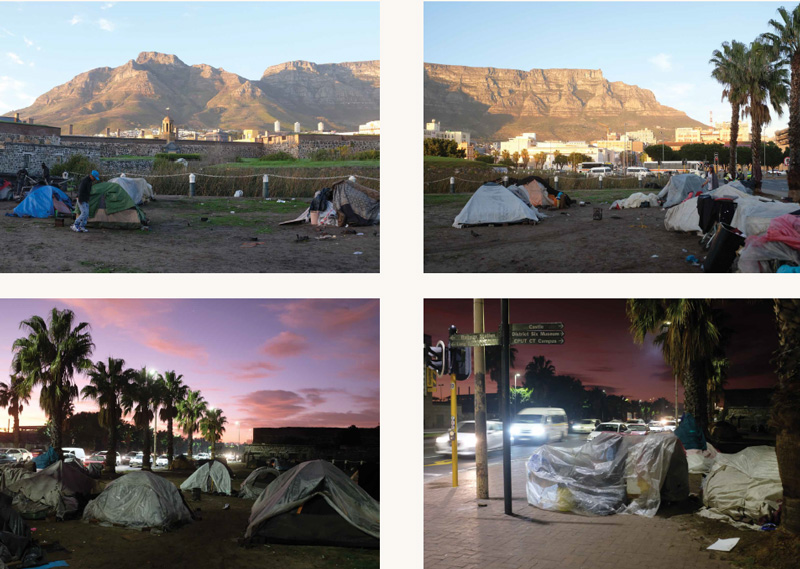
The Castle of the Cape of Good Hope. The site where Krotoa lived in the 1600s and where her remains have been buried symbolically.
Separation
On day one of the !Nau is a water ceremony.
A !Nau ritual of transition requires a Separation. But we must know what it is we are leaving behind. Krotoa’s story in the 17th Century gives us brutal reminders of the disconnection on so many deep levels that brought us here.
Separation from self
One of the clearest indications of the abusive treatment of Krotoa and others comes after 402 traumatised enslaved children arrive at the Cape in 1658 from Angola and Benin. Colonial commander Jan Van Riebeeck orders that they be given daily rations of alcohol and tobacco to pacify them.
KROTOA EVA VAN DE KAAP
Jan van Riebeeck writing in his diary.
In places the text is verbatim from the archive records of his journal.
We dare not trust Oedasoa and Eva.
But her love for tobacco and brandy keeps her coming back. Without tobacco, hardly any trade can be carried on here, which is not a bad thing for the Kompanjie.
The consumption is very great among all the natives, who madly yearn for it.
The other goods which they like are also copper and beads for which cattle is bartered remarkably cheaply from these tribes.
In the course of time, they may be glutted with these things, but their love for tobacco and alcohol will last forever and grow more and more.
May our Lords Masters have cause to thank His Most High Majesty in Whose merciful protection I command affairs here for the greatest service of the Company.
Cape of Good Hope
Johan van Riebeeck 1662
Separation from land
In 1659 a war breaks out between the colonials and the indigenous people. Krotoa is the main translator and a key negotiator to restore peace. When order is restored, there is increased VOC (Dutch East India Company) land encroachment, fortifications everywhere and an almond hedge, planted to border the stolen territory of the settlers.
Ek is heen en weer tussen hier en my swaer se huis.
Kaise goaxa tsi garu.
Geskenke gaan hier weg en vrede beloftes kom terug.
Sprake van vrede, maar hy skryf daar van sy begeerte om my mense te verdryf.
Om die Kaap af te sny.
‘n Amandel heining word gestig om ons mense hier uit te hou.
Orals is daar verdedigings begin.
(I am constantly between the fort and [Chief Oedasoa) my brother-in-law’s house
There is much coming and going.
Gifts are sent and promises of peace return.
Talk of peace but he journals about his desire to drive my people away.
To cut off the Cape.
An almond hedge is planted to keep our people out.
Everywhere fortifications are begun)
Krotoa Eva van De Kaap
Separation from Traditional Knowledge
The clash between indigenous belief systems and foreign practices is epitomised by Krotoa’s decision to protect herself when Van Riebeeck leaves the Cape by becoming baptised.
Money paid.
No harm done.
This is the way of these people.
Everything is a transaction
One transaction cancels the other.
A baptism washes away heathen superstition.
Maybe a marriage will wash away the scandal of a pregnant slave.
Everything is a transaction.
Letting go.
Sacrifice.
Loss.
Krotoa washed away in all this coming and going.
Weggewas met bloed.
Aob kha abe-e
Krotoa Eva van De Kaap
“This evil we have given the name of ‘separateness’ knows that it cannot last forever… Deep inside myself sits a twisted understanding of my place in the world. We have allowed the separateness to seep into every aspect of ourselves. There are apartheid churches, apartheid schools, apartheid social functions and apartheid sports. We live and dream this separateness. I become determined to forever lose the label ‘coloured’. My family is upset when I say we are black, even worse that we are African. Nobody is as offended when you say you are a Bushman. They just don’t take you seriously.”
The Keeper of the Kumm
Sylvia Vollenhoven
The revival of traditional culture and the growing First Nations consciousness holds out the hope of freedom from the trauma of the past.
Transition
In the Transition from a traumatic past to a new understanding of ourselves we enter a place of great uncertainty. But despite the landscape of our history being littered with lies and distortion our ancient knowledge systems live on.
We fan the embers of what we used to know and dance in the flames of renewal.
We carry our letters, our stories in our bodies Our stories talk, they quiver, they tap Our letters make our bodies move Our stories make our people silent In the silence we feel the tapping inside My flesh moves, my body shakes Drums beating, wings flapping The !gwe deep inside
– The Keeper of the Kumm
Based on the archival stories of //Kabbo, a 19th Century Bushman Visionary
Ouma Magdalena Lena Adolph of Van Rhynsdorp, plays the organ in the Roman Catholic Church. She has a statue of Mother Mary on her stoep and washes the crystals in her garden with ‘profetiese water’, water that infused with a ritualistic blessing. She talks with her Ancestors and makes the blood sacrifices they require.
We have to work out what to take along and what to leave behind on our journey to the new place. The !gwe deep inside will tell us.
Connecting the Dots
The play Krotoa Eva van De Kaap has been performed at many venues in the Netherlands and South Africa. A consistent aspect of this co production between Artscape (Cape Town) and Volksoperahuis (Amsterdam) has been the audience outreach with forums, discussion dialogue and workshops, mainly for youth.
In recent times there have been youth workshops at Artscape and two packed performances (about 1,400 students and learners) at the annual Stellenbosch University (SU) Woordfees.
The production and workshops have been supported by the Kingdom of the Netherlands Embassy in South Africa and the SU Woordfees. Krotoa was a young child when she was taken into the household of a colonial commander as a servant and a teenager when she fell pregnant for the first time. She was in her mid-teens when called upon to be a key negotiator and translator when war broke out beween the colonials and the indigenous people.
Many South African schools are still teaching history from a distorted colonial perspective that neglects the role of black people and women specifically. In the workshops we use creativity to demonstrate to young people what a life changing experience it is to address the gaps in their history and to make their voices heard, using their innate artistry.
The Krotoa Eva van De Kaap play tells the story of a young woman battered by a 17th Century reality. The work offers an opportunity for young South Africans to explore the modern consequences of a historic story and their own connection to the themes.
The Krotoa Youth Workshops use innovative Theatre in Education (TIE) principles to provide a ‘cognitive playground’ where young people experiment with different choices and experience the outcomes in a safe, fun environment. Arriving at a fresh understanding of crucial issues of Culture, Heritage and Identity.
They are guided by a team of professional facilitators and are encouraged to connect the dots between modern social dysfunction, historic events and hidden histories.
This exhibition captures some of the creative work produced by the youth in the workshops.
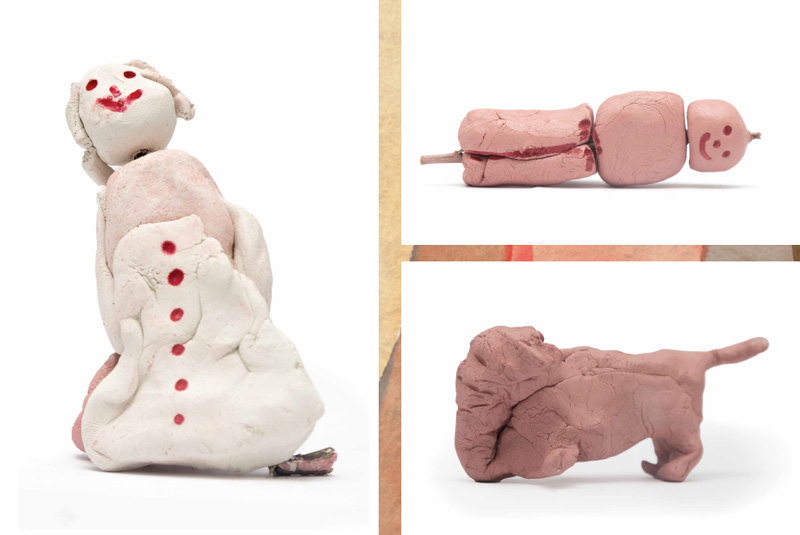
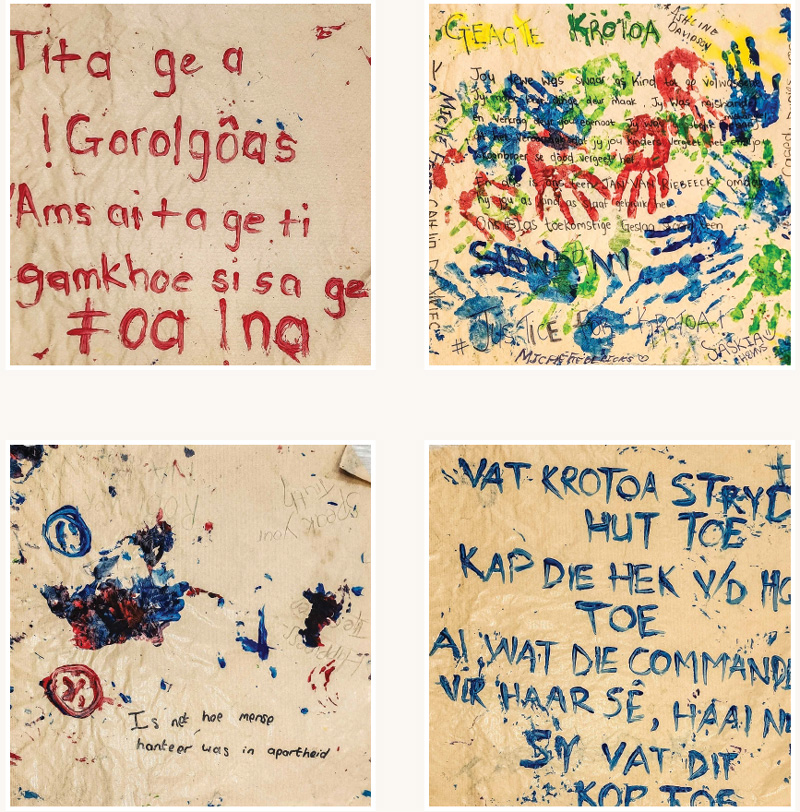

Sylvia Vollenhoven is the author of the play Krotoa Eva van De Kaap. It has inspired the project A !Nau for Now Crossing Oceans Inside.
Re-membering
On day three of the !Nau there is feasting and celebration. The initiates drink Buchu water.
For indigenous people identity is tied to everything that has gone before. It is an intricately interconnected state that is informed by worlds seen and unseen. When this understanding is overwhelmed by a less enlightened world view the disruption is tumultuous.
Putting ourselves back together again, Re-membering and Re-integration, requires a new consciousness that opens the doors of perception to invite the magic back inside. Ritual is the key to the door.
On a balmy autumn evening I climb Paarl Mountain with Julian Arendse, a First Nations leader, and Diviner Charl Pienaar. We do a full moon ritual at this sacred site. By
the seaside of Noordhoek, storyteller extraordinaire Piet Berendse with leaders Timo Gonnèma and Catherine Arendse, build a mini version of an ancient Bushman birthing enclosure. They tell of the sacred rites connected with the arrival of a baby. In Van Rhynsdorp ‘Ouma Lena’ Magdalena Adolph gives me a desert rose and a deep red rock for the journey home to Cape Town. She dreams of the !Nau for Now project, seeing 200 people riding zebras.
The !Nau for Now – Crossing Oceans Inside exhibition and project pays respect to the forces of Re-membering and Re-integration that is sweeping the world.
The renaming process for the Krotoa Building on the Stellenbosch University (SU) campus; the institution’s support for the !Nau for Now project; the SU collaboration with Artscape as well as the Universities of the Free State and Johannesburg; and the support from the Australian High Commission in South Africa, link these institutions to the groundswell of Re-membering.

Elder Autshumao Mackie Mackenzie, one of the Leaders conducting the !Nau in honour of Krotoa.
/Kaggen The Mantis
There is a visit from The Mantis everywhere I live and in many places I visit in recent years. My people believe /Kaggen The Mantis is a messenger of The Divine.
I see a Mantis in the bathroom of the farm cottage that is my temporary home. Instead of the usual green it is a soft brown colour. I check on the net to see why this one would be different. There is information about the brown Mantis originating in Australia.
It stops me in my tracks. I am busy writing a funding application to the Australian High Commission in South Africa for assistance with the !Nau for Now project.
When I go back into the bathroom after checking the internet, the Mantis is gone. The next day I find it again, sitting on my bedroom window this time. I am still busy writing the proposal for the Australian government. Two days later I finish the proposal. To express gratitude for Divine assistance with the writing I sit down on my yoga mat to do pahla with candles, kooigoed, snuff, tobacco, water and buchu. When I open my eyes after a long meditation, the brown mantis lies dead on the mat in front of me. It was definitely not there at the start.
A week later I am putting away my yoga mat. In the corner where it usually stands is a green mantis that looks like it is dying. I look closer and see that it is entangled in a long strand of my hair. Gently I remove my hair coiled around its legs and body. The Mantis walks across the floor and onto my bed. The next morning it is dead on the floor in my room.
After a weekend of working furiously to meet project deadlines, I prepare for a meeting on the Stellenbosch University campus (SU). It is a sunny Monday morning in autumn. A soft voice tells me to wear green today. I have long ago learned to obey.
At the meeting a colleague tells me there was a Mantis in her office this morning. She tells me she has a surprise for me. When we are done she takes into the main SU Library. There across one whole wall is a huge mural. It is a lifelike artwork depicting a bookcase with a collection of books. The university has had a poll for students and staff, asking people to nominate the books that have had an impact on their lives. Among authors I have admired all my life is my book The Keeper of the Kumm. In the mural it is perched on top of Andre Brink’s Bid Sprinkaan (Praying Mantis).
The Australian funding application is successful and the !Nau for Now project takes off. I do a ritual of gratitude for the messages /Kaggen The Mantis have brought me.
“Die Mantis kom altyd met ‘n boodskap. Jy moet vir jouself uitwerk wat die boodskap is (The Mantis always comes with a message. You have to work out for yourself what it is),” says Bushman Storyteller Piet Berendse when I tell him of these events.
I have mixed feelings about writing all these things. Putting it down on paper somehow reduces magical moments. The sheer breathlessness of it all, becomes almost prosaic. And yet that is what is required, to return to a way of life where we work closely with magical things all the time. We are surrounded by magic (for want of a less clichéd word) but we need to elevate our senses to perceive it and to harness this extraordinary power. And then we can make just about anything at all happen.
“Why, sometimes I’ve believed as many as six impossible things before breakfast.” Alice In Wonderland
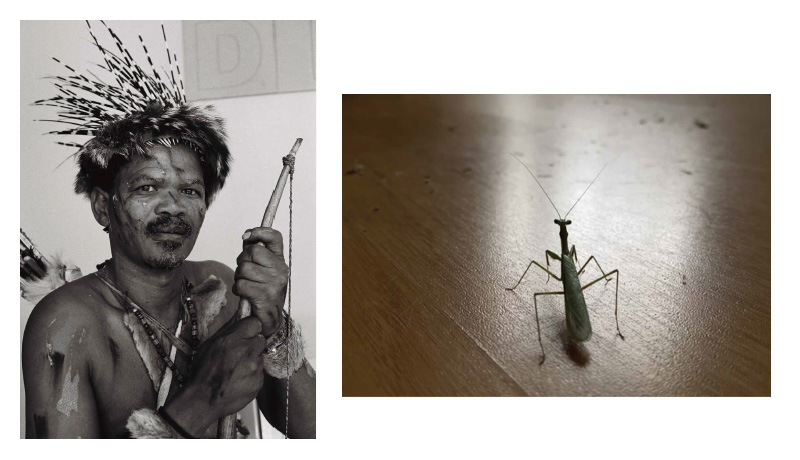
Piet Berendse Bushman Storyteller & Cultural Activist
The Elders
The Elders performing the !Nau in honour of Krotoa are Ouma Lena Magdalena Adolph of Vanrhynsdorp, Danab Bradley van Sitters and Chief Autshumao Mackie Mackenzie. During the preparations for the Ceremony Ouma Lena has a dream. Krotoa also talks with her. The Ancestral voice tells her how she was abused as a child and as a young woman. Without Ouma Lena having seen the play Krotoa Eva van De Kaap, she recounts fine details of Krotoa’s story from their encounter and some of it relates exactly to scenes in the theatre piece.
“Haar klere was van haar geskeur (Her clothes were torn from her). Sy was een keer geslaan en gegooi teen die vloer (Once she was beaten and thrown to the floor). Die is ’n boodskap vir jou hierdie. Ek ken mos glad nie vir Krotoa nie (This is a message for you. I don’t know Krotoa at all).”
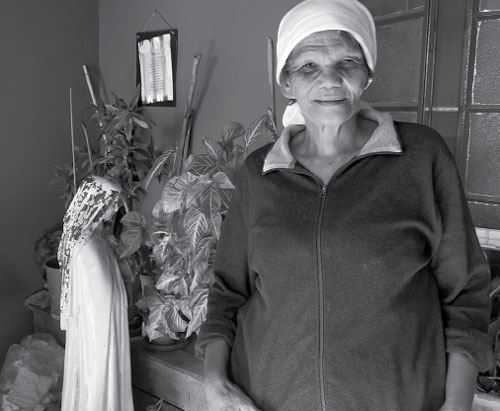
Ek het ‘n droom gedroom
‘n Regte droom
‘n Nare droom
Twee honderd mense wat op zebras ry
Die een man ry op ‘n kudu
Ek ry op ’n donkie kar
Met ‘n klaar geslagte bokvel en ‘n hond
Al my informasie sal in die wind
mee gehardloop word
Kyk maar net in die Droom Boek
Die is ‘n groot ding wat ons mee besig is
’n Ding binnekant ’n ding
Krotoa wil hê haar naam moet ook wees
Op ’n plek vir vrouens en kinders wat mishandle is
Haar naam kan nie sommer net so geplak word nie
Sy was vreeslik skeef behandel
Die is ‘n groot ding wat ons mee besig is
’n Ding binnekant ’n ding
Kyk maar net in die Droom Boek
– Ouma Lena Magdalena Adolph

Danab Bradley van Sitters
Crossing Oceans Inside
Artists from Australia fly 12,000 km to join hearts with their counterparts in South Africa. In the process they embark on a journey that explores their common history and connected First Nations present. With dance, music, song, ritual, visual art and poetry they arrive at a destination that requires Crossing Oceans Inside.
The celebrated Garage Dance Ensemble from O’Kiep (SA) and Australia’s Gurambilbarra, Townsville-based Wulgurukaba Walkabouts Dancers are engaging in a rare collaboration. Both groups fuse traditional indigenous artistry with modern inter-disciplinary art forms to produce work that is socially challenging and artistically unique.
The Dancers are joined by activist and performance poet Diana Ferrus as well as musician cum poet Jolyn Phillips.
Garage is led by the legendary John Linden and Alfred Hinkel. The Choreographer is Byron Klassen. Wulgurukaba (meaning canoe people with their sacred symbol of the Gabul carpet snake which is their creation dreaming story), is led by Ashley Saltner Jnr and are the winners of the 2022 national Performing Arts Connections Australia Impact Award for a cross-cultural collaborative performance project.

Garage Dance Ensemble – Namaqualand
Gurambilbarra in Australia’s North (traditional lands of the Bindal and Wulgurukaba people), is famous as the home of the great indigenous leader Eddie Koiki Mabo. Mabo is known for campaigning land rights and overturning the colonial legal concept of ‘terra nullius’ or ‘empty land’. In the Mabo decision (commonly called Mabo), the High court of Australia found in favour of Mabo, which led to the Native Title Act 1993 and established native title in Australia, officially recognising the rights of Aboriginal and Torres Strait Islander people in Australia to own and use the land on which their families had lived for millennia. One of Eddie Mabo’s grandchildren, William Koiki Mabo, now dances with Wulgurukaba Walkabouts Dancers.
Both Gurrimbilbarra (Townsville) and ||Hui !Gaeb (Cape Town), are dominated by and surrounded by mountains and hills. In SA Hoerikwaggo (Table Mountain) dominates the city, with the surrounding Hottentots-Holland or Gantouw pass ranges folding around it to the sea. In Gurambilbarra the city is dominated by Mandilgun / Gurrumbilbarra itself (Mount Stuart), Cutheringa (Castle Hill) and the surrounding mountain ranges of Barringha (Hervey Ranges). Both have politically important islands just off their coasts.
Bwgcolman (meaning one people from many groups – Palm Island) off Gurrimbilbarra has a population descended from people taken to the Palm Island Aboriginal Settlement from 1914 up to 1971. Estimates vary, but the number of tribal groups represented by the descendants (known as the Bwgcolman people) is at least 43 and has been said to represent 57 different language groups. At least 5 000 people were forcibly removed to the reserve from all over Queensland, the Torres Strait and Melanesian islands. The destruction of District Six in Cape Town resonates.
For many years Cape Town was home to one of the most famous freedom fighters in the world. Nelson Mandela was on Robben Island for 18 of the 27 years of his imprisonment. Having lived in Gurrimbilbarra most of his adult life, Eddie Mabo is regarded as one of Australia’s most influential figures.
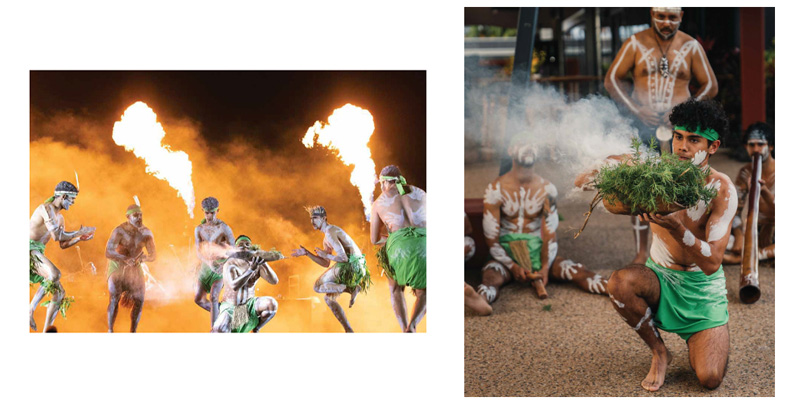
Wulgurukaba Walkabouts Dancers – Australia
REIMAGINING THE EXHIBITION SPACE AS RITUAL
The leadership of the First Nations and Khoekhoe of ||Hui !Gaeb (Cape Town) have revived the ancient !Nau Ceremony of Commitment and Dedication, for the rejuvenation of the indigenous people. It is redolent of a widespread need for social transformation and connects us with traditional cultural practices and with our ancestry.
The !Nau is a healing ritual that is being used to facilitate the movement away from a state of historic trauma to one rooted in indigenous values. From dis-ease to wholeness. It is also restoring the seamless transmission of culture from one generation to another.
In the transformation from one state to another via the three phases of the !Nau – Separation, Transition and Re-membering – the prior state ceases to exist.
The !Nau Ceremony of Affirmation and Dedication also serves to strengthen ties between age-old neighbouring groups in ||Hui !Gaeb (Cape Town). A revivalist movement is aiming to promote a sense of pride in indigenous identity.
A key element of this revival is the deconstruction and reconstruction of indigenous African history; the restoration of traditional systems of belief and practice; and the reclamation of ancestral languages and cultures.
This exhibition is an artistic reflection of the intensity of this revival at a personal and spiritual level.
South Africa’s indigenous people have borne the brunt of colonial and apartheid aggression. We have not begun to evaluate honestly the ongoing impact on the collective wellbeing of people who have been stripped of their sacred rites, names and languages. As a result of genocide and intellectual erasure the !Nau Ritual was not widely practiced in the 20th Century.
A group of Traditional Leaders will mark the Krotoa Building renaming and the attendant events with the honour of a !Nau Ceremony of Affirmation and Dedication. It will happen over several days in the lead-up to the formal renaming of the Krotoa Building in Africa Month. The proceedings are sacred and are conducted at a secluded place. This process is aimed at healing and cleansing for the individuals, groups, institutions and nations represented. This ritual marks a significant transition for the University, it’s partners in this venture and the nation.
It is being conducted at a time when we are experiencing major national and global upheaval.
The three phases of the !Nau and of the Exhibition are:
1. Separation | 2. Transition | 3. Re-membering and Reintegration
The Separation reaches into every aspect of our Beings strangling us from inside. Separation from history, from who we are. Then comes a necessary Separation, moving away from this dis-ease, away from the trauma of the past. When we are called upon to do the healing work in this way we pass by the gates of hell. But we are finally led to a major Transition, to a state of Re-membering and Reintegration.
Toa tama !khams ge
The struggle continues
The full exhibition will be available at the Stellenbosch University Museum – Directions
The Curators are Carine Zaayman and Lukretia Booysen.
Exhibition artists and contributors include:
Sylvia Vollenhoven – Concept, text, photographs & video
Basil Appollis – Director
Diana Ferrus – Poetry
Jolyn Phillips – Music & Poetry
Jimi Matthews – Photographs
Dieuwke-Jean Linee – Krotoa Portraits
Bradley van Sitters – Traditional Leader & Teacher
Piet Berendse – Traveling Bushman Storyteller & Teacher
Julian Emdon – Videographer
Garage Dance Ensemble – Namaqualand
Byron Klassen – Choreographer
Jaime-Lee Hine
Farrol Coetzee
Wulgurukaba Walkabouts Dancers – Australia
Ashley Salter Jnr
Eddie Koiki Mabo-Cohen
Kyla-Rae Saltner-Johnston

